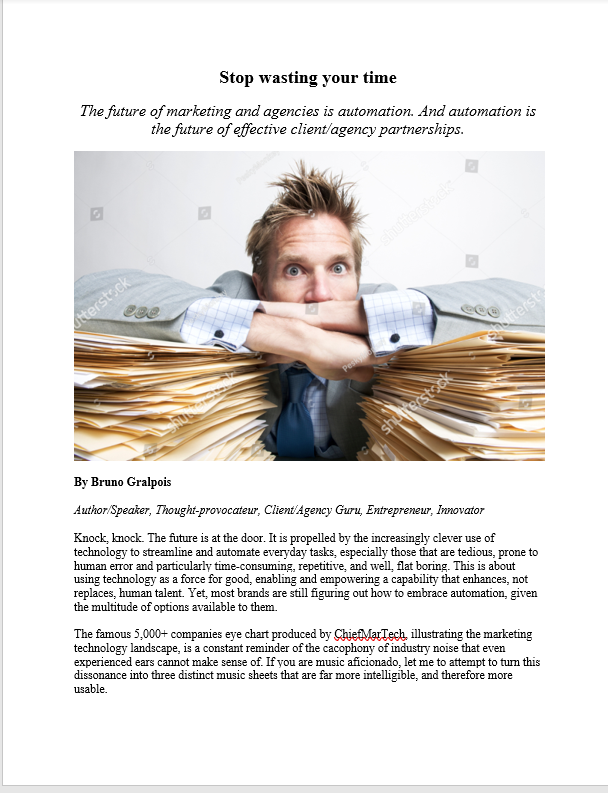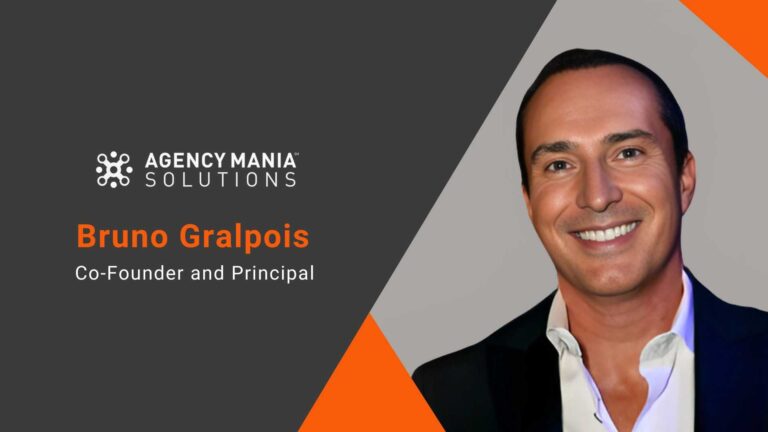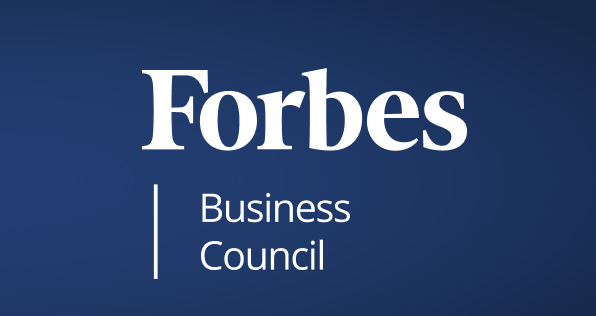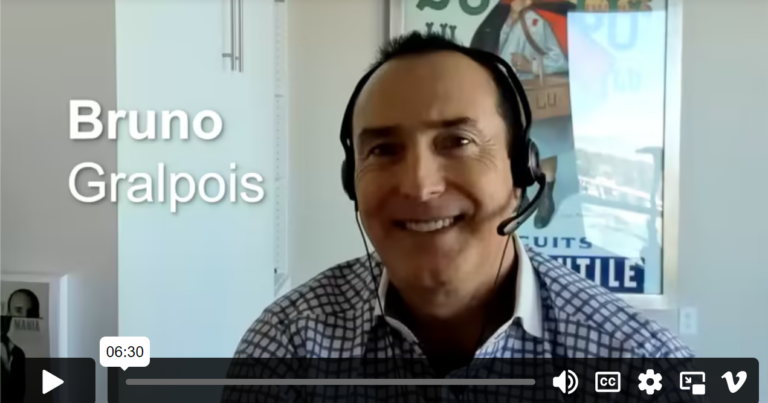Featured on 4A’s and ANA:
Stop Wasting Your Time:
— Read the published article on 4A’s —
— Read the published article on ANA —
Knock, knock. The future is at the door. It is propelled by the increasingly clever use of technology to streamline and automate everyday tasks, especially those that are tedious, prone to human error and particularly time-consuming, repetitive, and well, flat boring. This is about using technology as a force for good, enabling and empowering a capability that enhances, not replaces, human talent. Yet, most brands are still figuring out how to embrace automation, given the multitude of options available to them.
The famous 5,000+ companies eye chart produced by ChiefMarTech, illustrating the marketing technology landscape, is a constant reminder of the cacophony of industry noise that even experienced ears cannot make sense of. If you are music aficionado, let me to attempt to turn this dissonance into three distinct music sheets that are far more intelligible, and therefore more usable.
Automation in marketing
Marketing automation is slowly becoming a pleonasm. Perhaps, the same way the word “digital” is now unnecessary to describe it in marketing. Virtually everything in marketing is handled digitally. And technology is enabling most of these activities to be automated. In some ways, we have no choice: more data, more content, more places to distribute it, and simply stated, more to do, often with less, and necessarily faster. Marketing automation enables organizations to streamline increasingly fragmented and complex marketing workflows and repetitive tasks to increase operational efficiencies and speed to market, and ultimately to grow revenue.
The range of applications is widening. Forrester estimates the global marketing automation technology category will reach $25 billion by 2023. In its “Marketing Automation Technology Forecast, 2017 to 2023,” Forrester refers to six technologies within the marketing automation ecosystem: cross-channel campaign management software, content marketing platforms, lead-to-revenue management automation platforms, marketing resource management software, real-time interaction management solutions, and through-channel marketing automation platforms. As a result, a greater share of marketing budgets is now allocated to marketing technology so brands can do more, faster and better. Marketing platforms like Adobe Marketo are centralizing many of these daily marketing activities from project and resource management to content creation and management, asset management, database and CRM systems, analytics, and more.
Automation in the agency world
Agencies are a colossal part in the marketing journey. So naturally, doing more for clients can get very expensive unless they, too, find ways to operate more efficiently and seamlessly. In their report called “The Agency Workforce 2023: Automation and AI Will Reshape Media and Creative Agencies,” Forrester estimates that agencies will automate as much as 11% of their workforce by 2023. Most of that change is likely to occur within administrative, lower-value, error-prone functions that are known to rely on labor-intensive but also repetitive tasks. Agencies have led efforts to reshape how they work or even interact with clients. They are bringing automation to everything they do–especially in media, analytics, and production–including doing work in a fraction of the time that was previously required or delivering more accessible, fluid, collaborative, and productive client experiences. Notably, robotic process automation (RPA) company UiPath realized a valuation of $10.2 billion earlier this year.
Bonjour Marcel! Marcel has been the well-publicized AI-driven project management platform concept launched by Publicis Groupe (and named after founder Marcel Bleustein-Blanchet who created Publicis in 1926). The beta was introduced mid-2018 by Microsoft CEO Satya Nadella and Publicis Groupe CEO Arthur Sadoun. Per Publicis, “Marcel is a platform designed to help employees of Publicis Groupe learn more, share more, and create more than ever before” across its 80,000 employees worldwide. Although Marcel is meant to enable many enterprise-wide activities, a key focus is on turning tedious, highly manual processes like processing invoices, timesheets, or expense reports into easier, faster tasks. Good timing given the new environment.
Another holding company, Dentsu, has also been advocating for a new world order, fueled by innovation using robotic process automation and AI services (RPA or RPAAI). Dentsu kicked off an eight-year project, led by its Chief Automation Officer, Max Cheprasov, to streamline thousands of their existing processes. An Automation Center of Excellence is responsible for the development and deployment of “effective and innovative intelligent automation solutions and AI-powered virtual assistants (using ML, NLP, IPA, RPA, OCR), augmenting employee experience, enhancing customer service, and boosting efficiency and effectiveness.” With the help of Catalytic, they reduced manual efforts by 68% on average for mid-office media activation processes at Dentsu. In another example, using FortressIQ, the agency relied on just two people to automatically mine, model, and document over 2,200 processes across the business instead of what would have required 30 people to do manually.
Automation in client/agency partnerships
Some of the highest labor-intensive tasks and countless, repetitive but necessary activities are centered around the planning and management of the work itself and the financial relationship, including retainer tracking, progress tracking, data reconciliation, and performance reviews. All are essential tasks to support and improve the work relationship between marketers and their agencies. All require significant investment in time and effort across both organizations. All are prone to human error, especially as the size of the agency or client organization increases. Luckily, these processes can be reengineered, simplified, and automated. If you work for a large corporation, you know too well that organizational and functional workflows require multiple approval levels and back-and-forth exchanges requiring formal documentation and versioning control. All of these partnership activities should be streamlined with the right technology to free up valuable time that can be reinvested in doing the most impactful work.
Much of the debate about the use of automation has been about the risks of displacing human labor. Misconceptions or realities? No one really knows yet, as we are learning what to automate–or what not to automate. Yet, the most useful applications for automation in marketing, among agencies or in client/agency partnerships, will enhance human productivity, combining technology and human labor to realize benefits from both. The question remains: who has the luxury to waste time these days? If done properly, we all hope to see that the power of automation will free marketers and agencies to use their time more productively and focus on value activities that pay higher dividends in the long run.
By Bruno Gralpois, Author/Speaker, Thought-provocateur, Client/Agency Guru, Entrepreneur, Innovator
November 17, 2020







